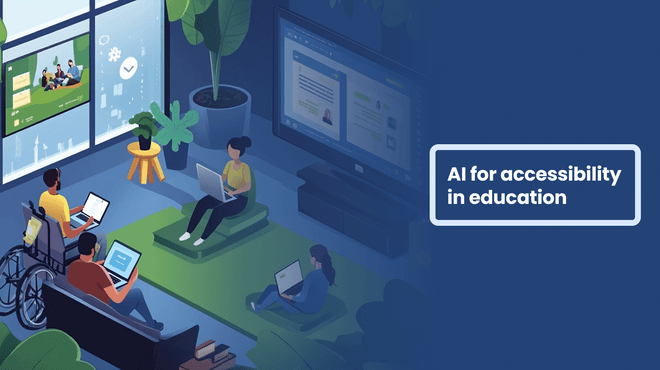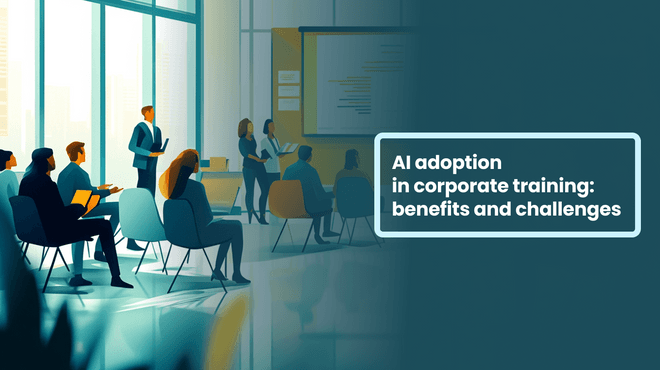The ultimate guide to future-ready corporate training

The world of work is changing. Companies today must learn and adapt faster than ever.
Imagine being on an escalator that keeps speeding up – that’s the reality businesses face today.
Currently, the global corporate training market is valued at $352.66 billion.
What drives this growth, how is corporate learning different from corporate training, and what is AI contributing to the process?
In this article, we will discuss corporate learning and how technologies like LMS software and AI-based solutions have made it more effective. We will also share recommendations from Aristek experts on seamlessly implementing new developments.
What is corporate training?
Corporate training is a strategic approach to developing employees’ skills and competencies through structured learning programs. It includes both internal and external initiatives designed to enhance workforce performance, drive business growth, and prepare organizations for future challenges.
Corporate training is a key investment in a company’s future and employee well-being, built on four pillars:
- Learning loops – Structured, repetitive learning that promotes active engagement, deepens knowledge, and reinforces skills through interactive methods.
- Reflection – Encourages self-awareness and continuous improvement, fostering better collaboration and informed decision-making.
- Knowledge acquisition – Equips employees with new skills through training, workshops, e-learning, webinars, coaching, and more.
- Behavioral change – The most challenging yet crucial step, requiring a mindset shift and willingness to apply new skills in daily work.
These pillars serve the following key objectives for businesses:
- Increase learning speed: quickly build future-relevant skills and stay ahead in an era of rapid innovation.
- Enable new techniques: bring essential future skills into your company and establish modern learning and working concepts.
- Performance boost: foster self-directed learning and create measurable value for business.
Corporate training can be seen as an umbrella term, encompassing eLearning and other training methods as subcomponents and possible approaches.
However, despite both corporate training and corporate learning offering pathways to gain skills and knowledge, they differ a bit.
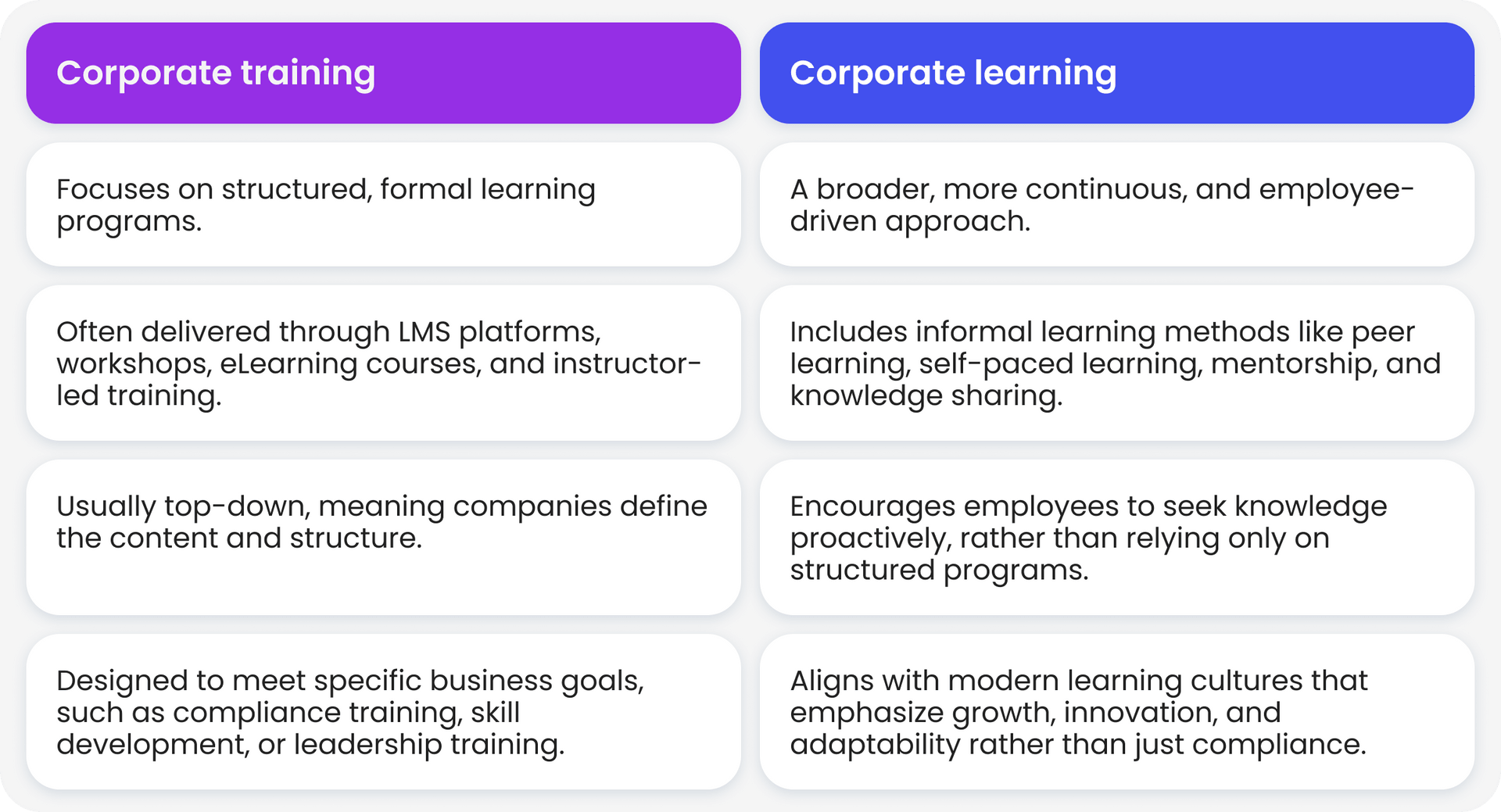
Difference between corporate training and corporate learning
Corporate training for employees can be implemented in various forms. The most important ones are:
- Internal or external courses (e.g., seminars, language courses);
- Congresses, trade fairs, and symposia;
- Exchange programs, such as partnerships with other companies;
- Self-learning, especially through digital platforms, and more.
Modern digital learning platforms, such as Learning Management Systems (LMS), collect extensive data that is valuable for calculating the return on learning:
- Usage statistics: Who learns when, for how long, and with what content?
- Learning progress: How do employees’ skills and knowledge levels develop?
- Automated assessments: How well do employees absorb and apply new knowledge?
This digital data enables timely and continuous tracking of learning effects, rather than relying solely on point-in-time measurements after training completion.
In the corporate training segment, key applications include:
Formal learning:
Personalized course recommendations and hybrid learning models application;
Automation of administrative tasks such as analysis or correspondence;
Adaptive learning tailored to prior knowledge and skills, assessed through questions or interactions;
Research and summarization of relevant literature.
Collaborative learning:
- Peer recommendations for learning;
- Chatbots for onboarding, and presentation training;
- AI-powered support, including automated Q&A and content creation and maintenance;
- Self-coaching and mentoring through intelligent chatbots.
On-the-job learning:
- Digital assistants providing guided instructions and micro-learning within workplace tools;
- Integration with AR/VR and the Metaverse for hands-on training with real-world applications
- AI-driven assistants answering work-related questions in real time
- Automation of repetitive tasks, allowing employees to focus on higher-value learning and problem-solving
L&D representatives usually highlight the following three reasons why corporate learning is essential nowadays.
1. Upskilling & reskilling
With rapid technological advancements, many employees lack the skills needed for evolving job roles. Upskilling and reskilling ensure businesses stay competitive by equipping workers with relevant skills.
This trend was echoed at the World Economic Forum – for over 85% of employers, upskilling workforce is the #1 in the list of workforce strategies, considering that 50% of all employees will need
reskilling by 2025.
The 2024 Digital Learning Realities survey by Fosway Group, in partnership with Learning Technologies, highlights a significant shift in employee training priorities.
In 2023, upskilling and reskilling ranked third, but due to rapid technological changes, it has surged to the #1 priority for L&D professionals. In 2024, it overtook career development and compliance, reflecting the growing need for adaptability in the workplace.
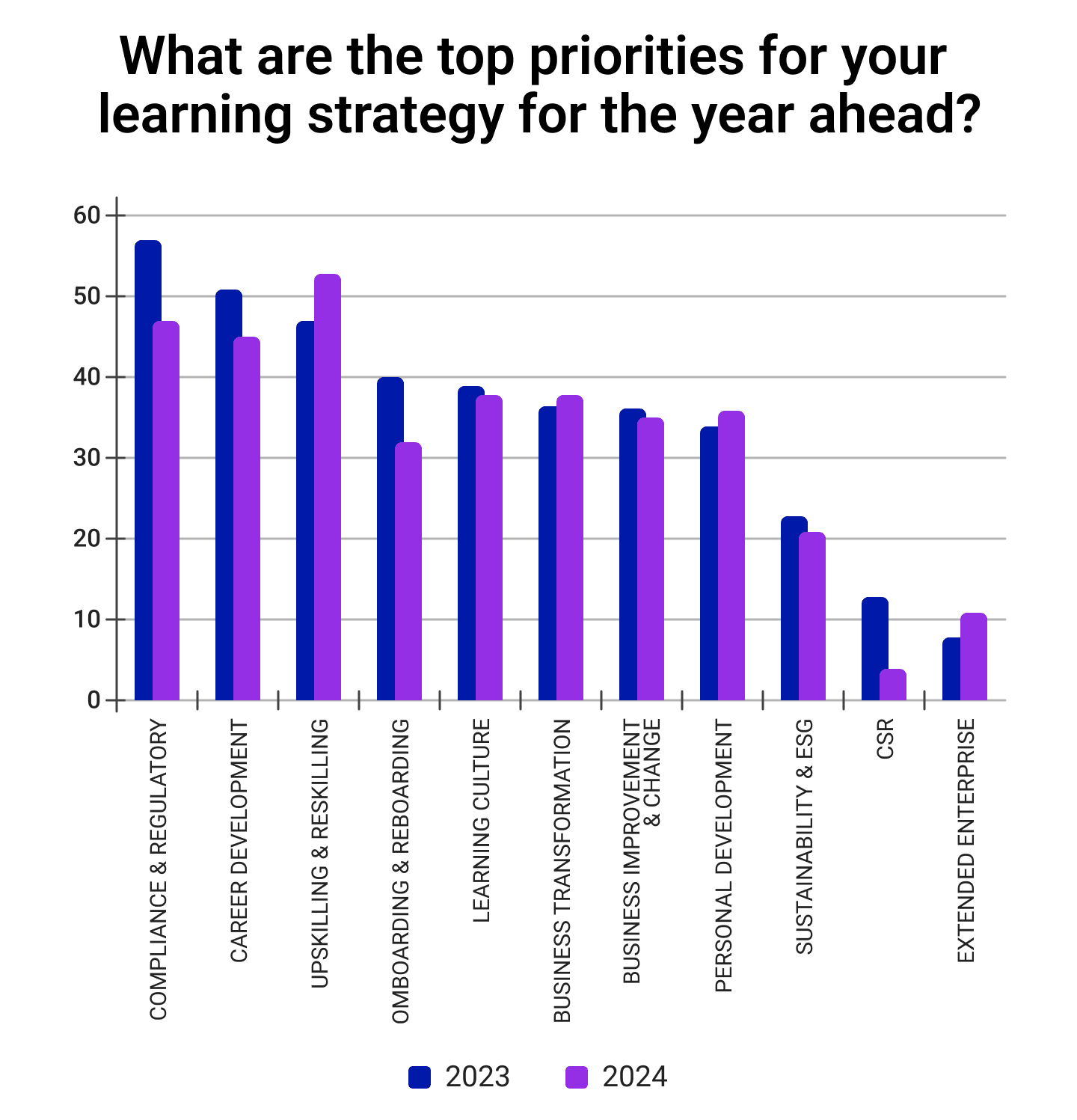
What are the top priorities for your learning strategy for the year ahead
AI tool for talent development and upskilling
Discover how we integrated an AI-driven training and assessment system into a US-based microelectronics manufacturer’s LMS, resulting in a 67% reduction in instructor workload.
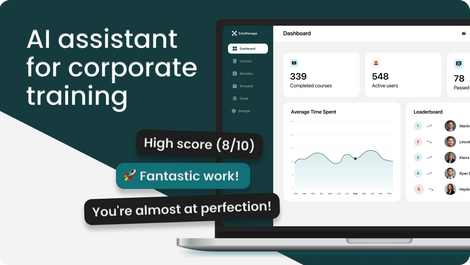
2. Increased employee engagement & retention
Employee engagement is the level of energy that employees invest in achieving good results and moving their company forward. Providing training opportunities fosters a culture of growth, boosts motivation, and reduces turnover by showing employees they are valued.
A Gallup study found that highly engaged teams show 21% greater profitability and 17% higher productivity than disengaged ones.
Additionally, research from Zippia suggests that 40% of employees would be more engaged if they were more satisfied with their roles.
This underscores why corporate learning is essential: it equips employees with the skills and confidence to navigate change and adapt to new challenges.
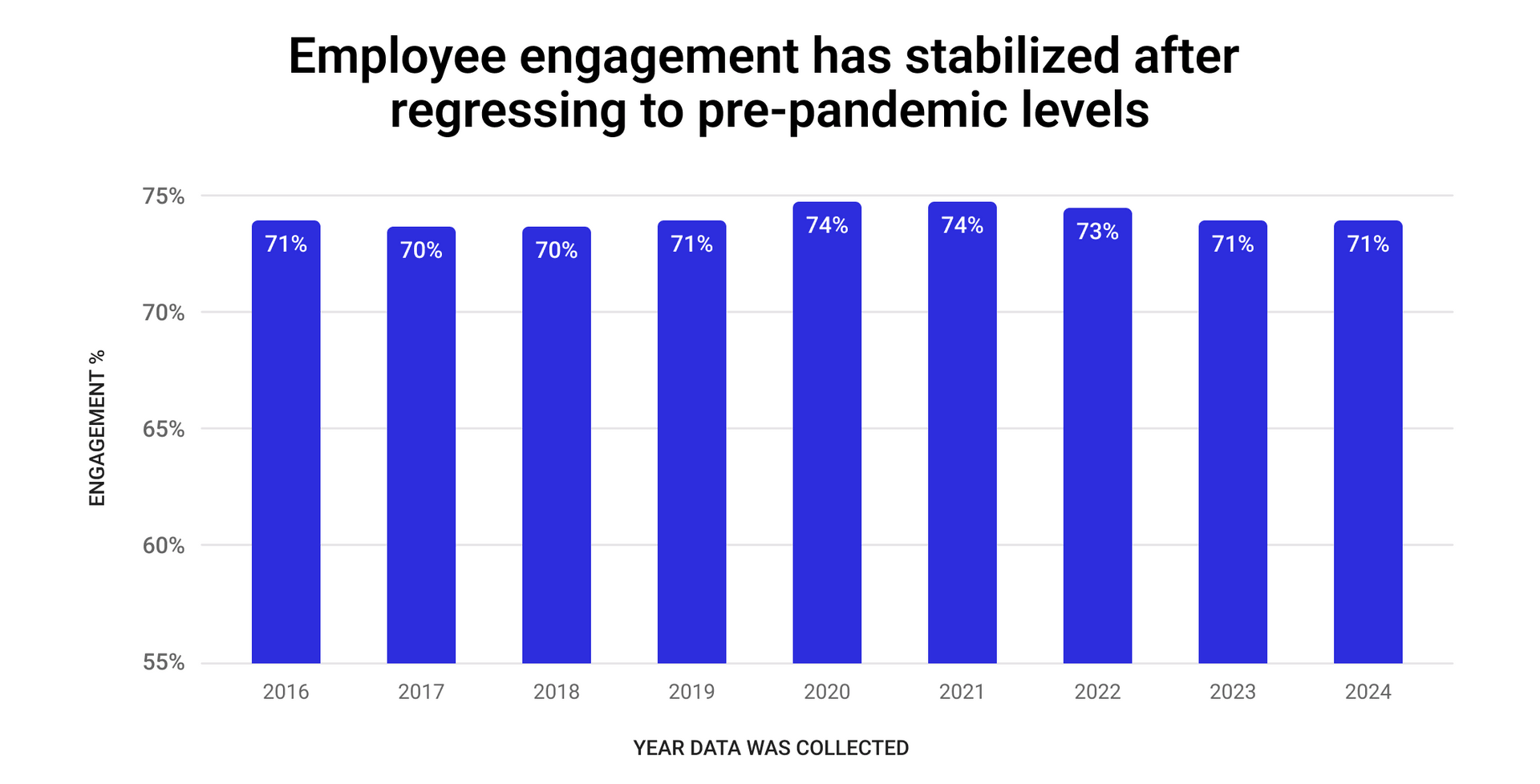
Employee engagement graph
Luckily, despite the onslaught of unknown factors – economic uncertainty, AI disruption, the ongoing shift to hybrid work models, and more – employee engagement is returning to pre-COVID levels.
However, this doesn’t mean companies should become too comfortable. In short, L&D can be a key driver in keeping employees both externally and internally motivated in the following ways:
- Enhance onboarding for retention – A structured onboarding process with clear growth opportunities increases employee retention, especially among millennials, who prioritize career development.
- Leverage internal talent – Identify and upskill existing employees to fill labor gaps, fostering career growth while addressing workforce shortages.
- Integrate learning into workflows – Go beyond traditional training by implementing immersive, on-the-job learning through mentorship, peer collaboration, and real-world scenarios.
3. Digital innovation
Automation, once limited to repetitive tasks, now extends to knowledge work, creativity, and even artistic activities.
- Corporate training software (LMS/LXP) personalizes learning and tracks progress.
- Robotic process automation (RPA) tools reduce manual effort by streamlining administrative tasks.
- Data analytics platforms provide deep insights for better decision-making.
- AI-driven solutions (GenAI) optimize processes and generate intelligent recommendations.
In a ridiculously long list (yes, that’s the actual name), we’ve gathered 100 sources to equip you with best practices, sound tips, and innovative tools.

How has corporate training software been developing?
Today, we stand between data-driven and cognitive learning systems. With the advent of technology, especially specialized learning software, training has reached a new level.
The evolution of corporate training has been as dramatic as the shift from slash-and-burn farming to self-driving modern machinery. Let’s explore it in more detail.
1. The struggle before tech
As industrial revolutions rolled in one by one, the need for skilled workers skyrocketed – yet training still relied on repetitive, time-consuming lectures.
Keeping track of progress? Nearly impossible.
2. The rise of training manuals & correspondence courses (mid-20th century)
To scale learning, businesses began using printed training materials and mail-based correspondence courses. While more accessible, they lacked engagement and real-time feedback.
3. Early computer-based training (CBT) (1970s–1990s)
As technology advanced, companies experimented with computer-based training programs. These were self-paced but often dull, with limited interactivity and no real data tracking.
4. The first LMS wave (2000s)
Companies introduced Learning Management Systems (LMS) to digitize training and centralize content. While this made training more structured and scalable, it quickly became clear that simply offering large course catalogs wasn’t enough. Employees needed competency-based learning and career-aligned development to stay engaged and grow effectively.
5. The rise of experience-driven learning (2010s)
With the rise of social media platforms like YouTube (2005) and Twitter (2006), corporate training has become more personalized – just as social media algorithms adapt content to individual preferences.
Consequently, employees preferred dynamic, easily accessible content over rigid course structures.
6. The microlearning & mobile boom (2010s–mid-2020s)
The smartphone revolution (iPhone 2008, Instagram 2010, TikTok 2015) popularized short-form content, leading to microlearning.
Microlearning is based on Hermann Ebbinghaus’s forgetting curve, which shows that people forget about 80% of what they learn in a month.

Ebbinghaus’s forgetting curve
However, using the right study methods can improve retention. The researcher also found that reviewing information after a break makes remembering easier.
Small learning steps with small chunks of information today can be used for on-the-fly and on-demand learning. In this way, microlearning enables professionals to remain relevant in their profession.
7. Content & skill-based training expansion (late 2010s–2020s)
Content providers like LinkedIn Learning, Coursera, Udemy, and aggregators like Go1 and OpenSesame fueled the corporate learning ecosystem, emphasizing on-demand, skill-based training.
The “skills system of record” emerged, where platforms categorized and recommended training content based on employee competencies.
By the way, have you wondered what skills will be in demand soon? According to the World Economic Forum’s research, technology skills are expected to grow significantly.

These technological skills are complemented by creative thinking and learning flexibility
8. The shift to talent intelligence & capability academies (2020s–present)
These days, AI-powered corporate training systems have become the standard to adhere to. Companies started integrating AI into LMSs, LXPs, and talent marketplaces to create seamless, end-to-end learning ecosystems.
Future-oriented learning management
Enhance learning with intelligent chatbots, automated quiz creation, anti-cheating tools, personalized learning paths, and teacher assistance for a more engaging and efficient experience.
If you’re new to this concept, check out an LMS vs. LXP comparison here.
9. AI-driven personalization & learning transformation (2023–future)
Since the release of OpenAI’s generative AI ChatGPT-3 in November 2022, AI has fundamentally transformed corporate training by enabling real-time, adaptive learning experiences that generate customized courses based on individual needs.
McKinsey’s study shows that generative AI’s use in the corporate segment has increased dramatically since its introduction.
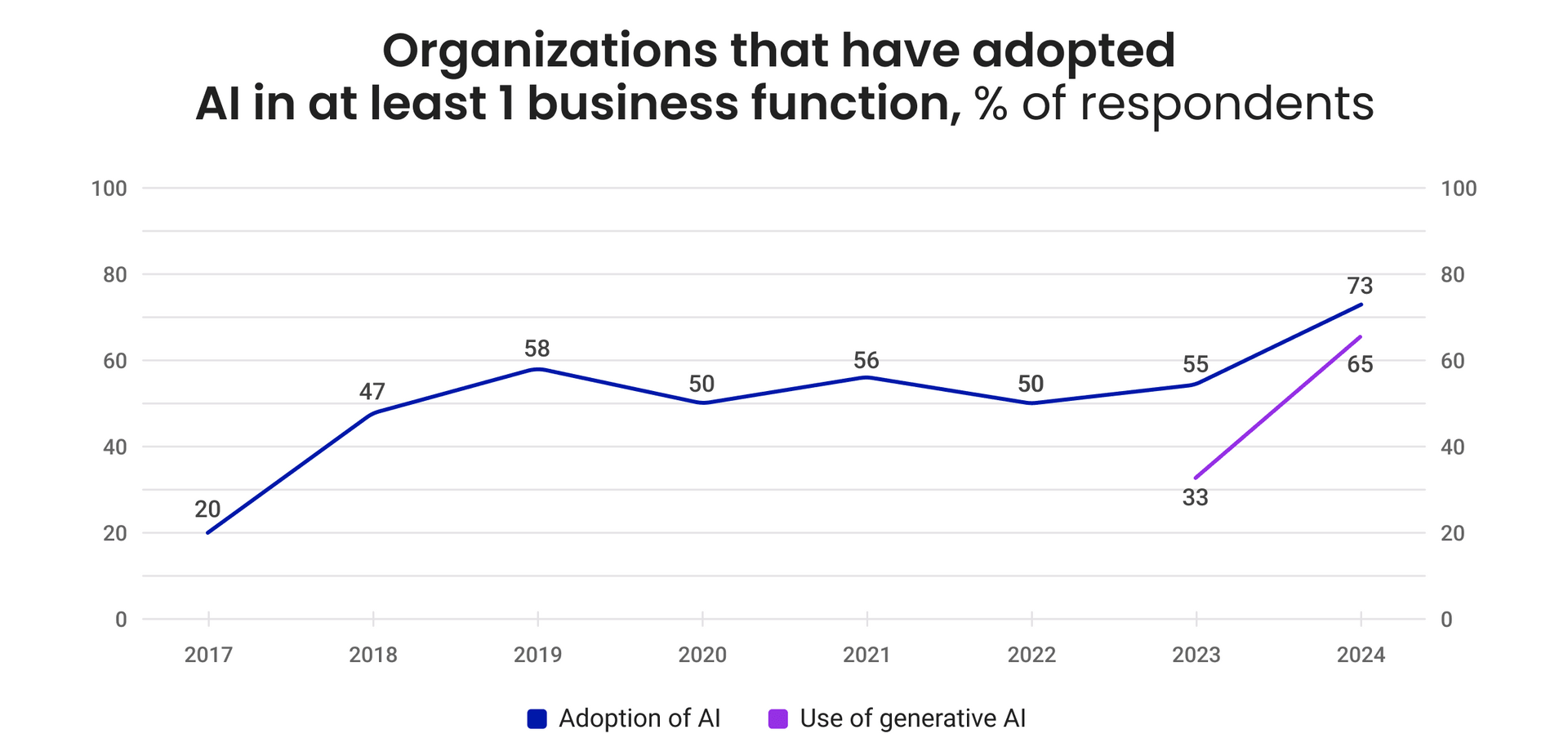
AI adoption curve
In 2023, only a third of respondents regularly used generative AI across two or more business functions. By 2024, that number had already risen to 65%.
These are the features that have become the hallmarks of today’s systems:
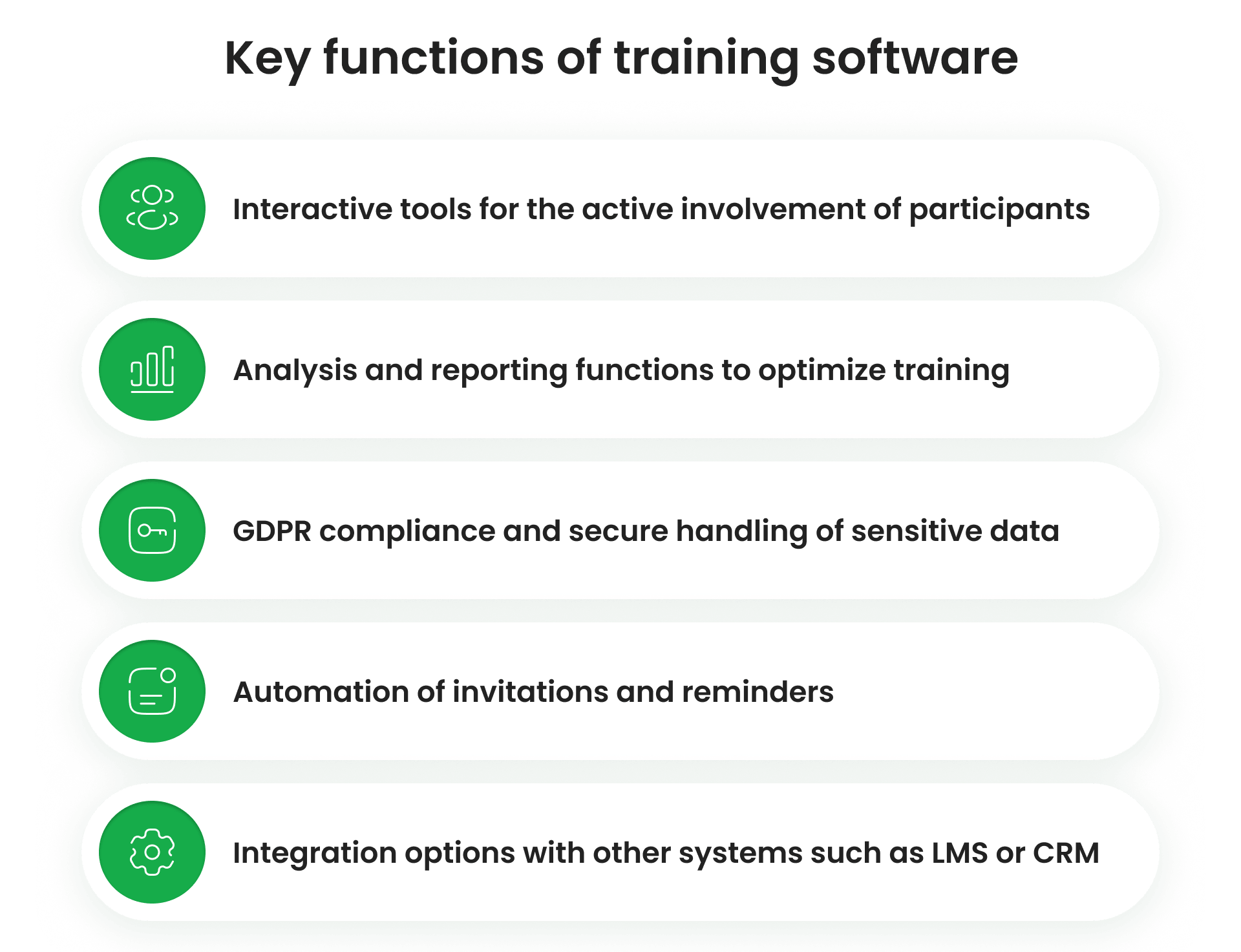
Key functions of training software
Benefits and challenges of corporate training software
By the beginning of 2025, we have prepared the top companies specializing in LMS software. In this list, we provide a detailed overview of the different types of LMS available on the market and highlight the key features of each.
The use of an enterprise LMS platform for corporate training has many benefits:
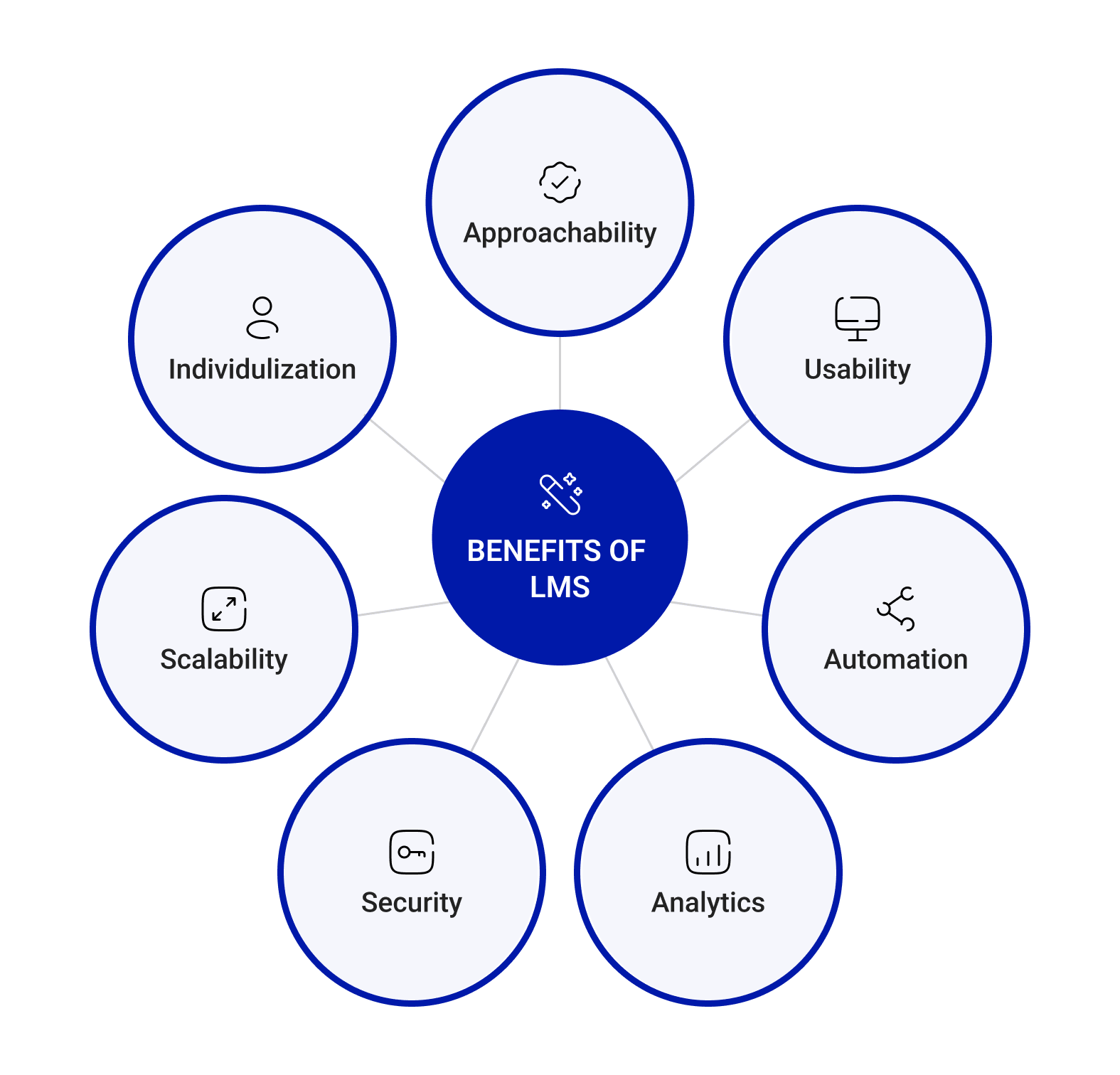
Benefits of LMS
- Approachability: Enables learning anytime, anywhere, on any device or operating system.
- Usability: Intuitive interface with features like quizzes, discussions, and grade tracking for seamless learning.
- Automation: Reduces errors and speeds up problem-solving through automated process control.
- Individualization: Adapts training to business needs with personalized learning paths.
- Security: Protects user data, financial information, and ensures compliance.
- Scalability: Supports business growth by integrating new technologies without limitations.
- Analytics: Provides dashboards to track progress, highlight weak areas, and improve learning outcomes.
To dive into enterprise LMS features, read this article.
In contrast, the following negative aspects also exist:
- Interruption of work processes due to participation in further training.
- Amortization of training costs with a time delay.
However, setting clear learning objectives, making learning convenient, rewarding participation and exceptional performance, and some other measures can help mitigate possible implementation issues.
In a dedicated blogpost, we share two major ways you can improve both the process and outcome.
After all, investing in corporate training evidently reduces staff turnover by enhancing job satisfaction and career growth.
A one-year study by Glint involving 75 companies, 15 industries, and over 500,000 employees found that those with low engagement scores were 5 times more likely to quit within six months and 12 times more likely to leave within a year.
Improved customer service
Well-trained employees deliver better customer experiences, directly impacting revenue.
Research from PwC indicates that 73% of customers consider their experience a key factor in purchasing decisions, and studies show that up to a third of customers are willing to pay more for excellent service.

Enthusiastic, knowledgeable employees foster stronger customer relationships, increasing satisfaction and loyalty.
Higher revenue & business growth
The combined benefits of corporate training – higher productivity, better retention, and increased engagement – drive stronger financial performance. The percentage of employees who agree with the statement, “Learning helps me adapt during times of change,” grew by almost 40% from 2022 to 2025.
Consequently, companies with engaged employees generate 2.5 times more revenue than those with lower engagement.
How to get started with corporate training software
They say the goal without a plan is just a wish. Leveraging our 22+ years of experience in software development, we can recommend following these three guidelines from the outset:
1. Assess your company’s training needs.
Identify key learning objectives, employee skill gaps, and compliance requirements to ensure the needed software aligns with your business goals.
In case you need AI implementation consulting, don’t rush to click on the first link at the top of your search – check out our selection guide first to understand exactly what a productive consultation should include. There, we explain how to make a thoughtful choice.
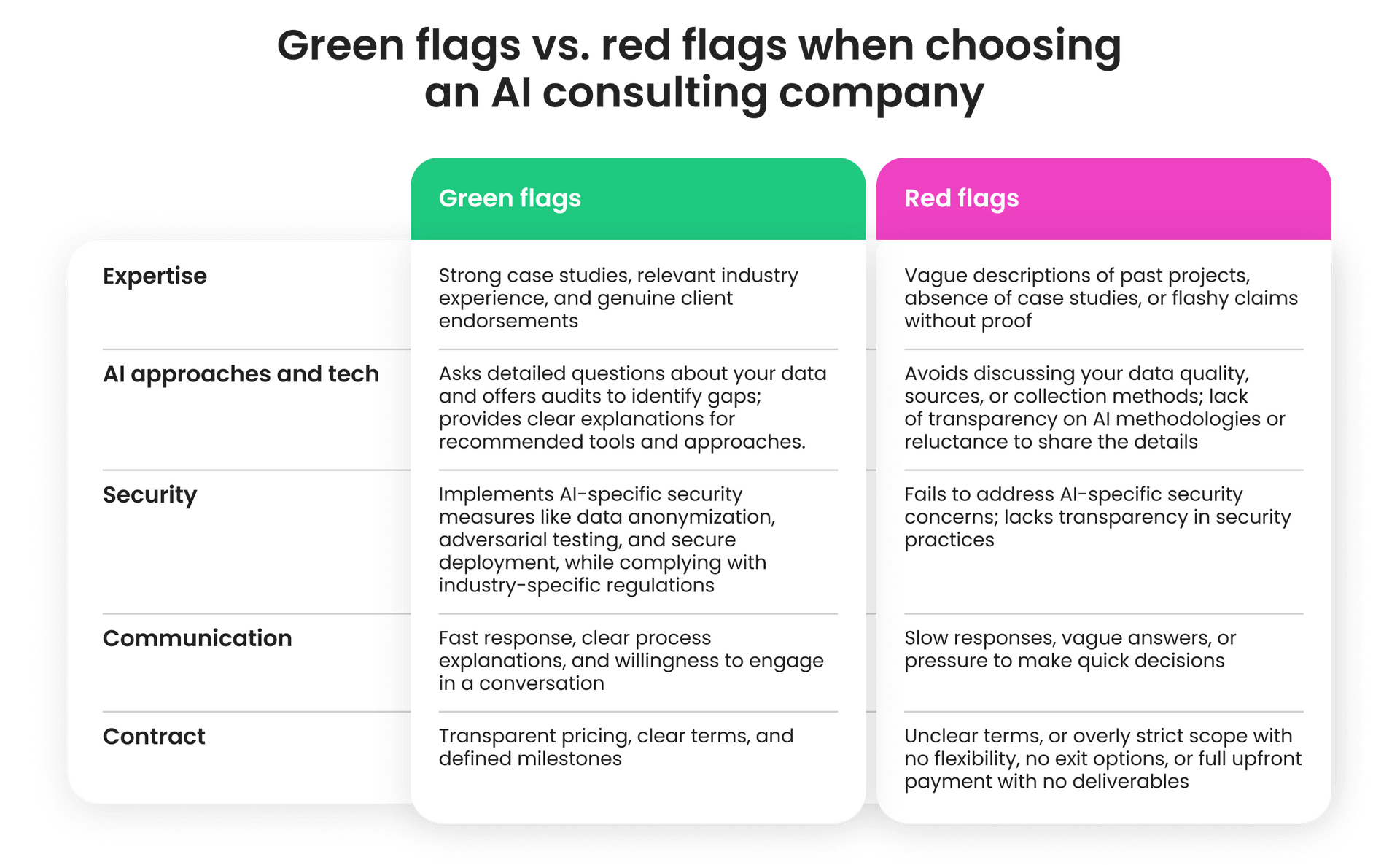
2. Prioritize system security and data protection.
A good corporate training platform should include robust encryption, secure access controls, and compliance with data protection regulations to safeguard sensitive employee information.
To stay ahead of AI security, explore the major regulations for AI compliance in this material.
3. Ensure seamless integration with existing systems
The software must integrate with HR, compliance, and performance management tools to streamline training processes and data management.
Get an ultimate LMS guide
This guide covers everything you need to know about LMS – and more! If you still have questions after reading, we’ll be happy to help.
AI adoption in corporate training
Where did the AI craze come from? Simply put, the flaws of traditional education have become too big to ignore in an era of rapid digital transformation.
The most noticeable limits of traditional content include:
- Manually creating, updating, and delivering training content requires significant time and effort from L&D teams.
- Static content struggles to keep up with evolving industry trends, regulations, and business needs.
- One-size-fits-all training often fails to address individual skill gaps, job roles, or learner preferences.
- Training quality varies depending on the instructor, materials, and delivery method, leading to uneven learning experiences.
Today, AI is transforming how people learn, work, and build careers, while L&D initiatives drive agility, innovation, and critical skill-building in the workplace – contributing to an estimated 11.7% growth rate from 2025 to 2030.
However, despite the considerable growth and limits mentioned above, some organizations avoid adopting new technologies. Many companies hesitate due to three common myths about AI – causing them to fall behind their competitors.
Let’s dispel these myths!
Myth 1: AI implementation is complex
- The real challenge isn’t AI itself – it’s the endless hours spent manually developing and updating training content. AI streamlines the process, saving time and effort.
- Most AI tools seamlessly integrate with your existing LMS, knowledge bases, and content libraries, so there’s no major tech hassle.
- AI-driven learning solutions are built for L&D teams, not IT departments—meaning they’re user-friendly and easy to manage.
Myth 2: AI-generated content lacks engagement
- AI creates interactive, personalized learning experiences.
- It doesn’t just churn out content – it adapts it to roles and learning preferences.
- AI-powered scenario-based training helps employees practice real-world skills instead of just passively absorbing information.
Myth 3: AI will replace L&D jobs
- AI isn’t here to take over – it’s here to assist. It automates repetitive tasks and identifies knowledge gaps to reinforce skills.
- Human trainers bring what AI can’t – critical thinking, empathy, and leadership coaching. AI handles data and analytics while trainers can focus on high-value interactions.
- AI-driven insights give trainers a clearer picture of learner progress, making it easier to measure ROI and personalize learning interventions.
A McKinsey study dispels final doubts about AI adoption. While many entrepreneurs believe implementation takes time, most businesses start using generative AI within one to four months after launching a project.
Below we provide examples of AI-driven solutions to real-world challenges our clients face:
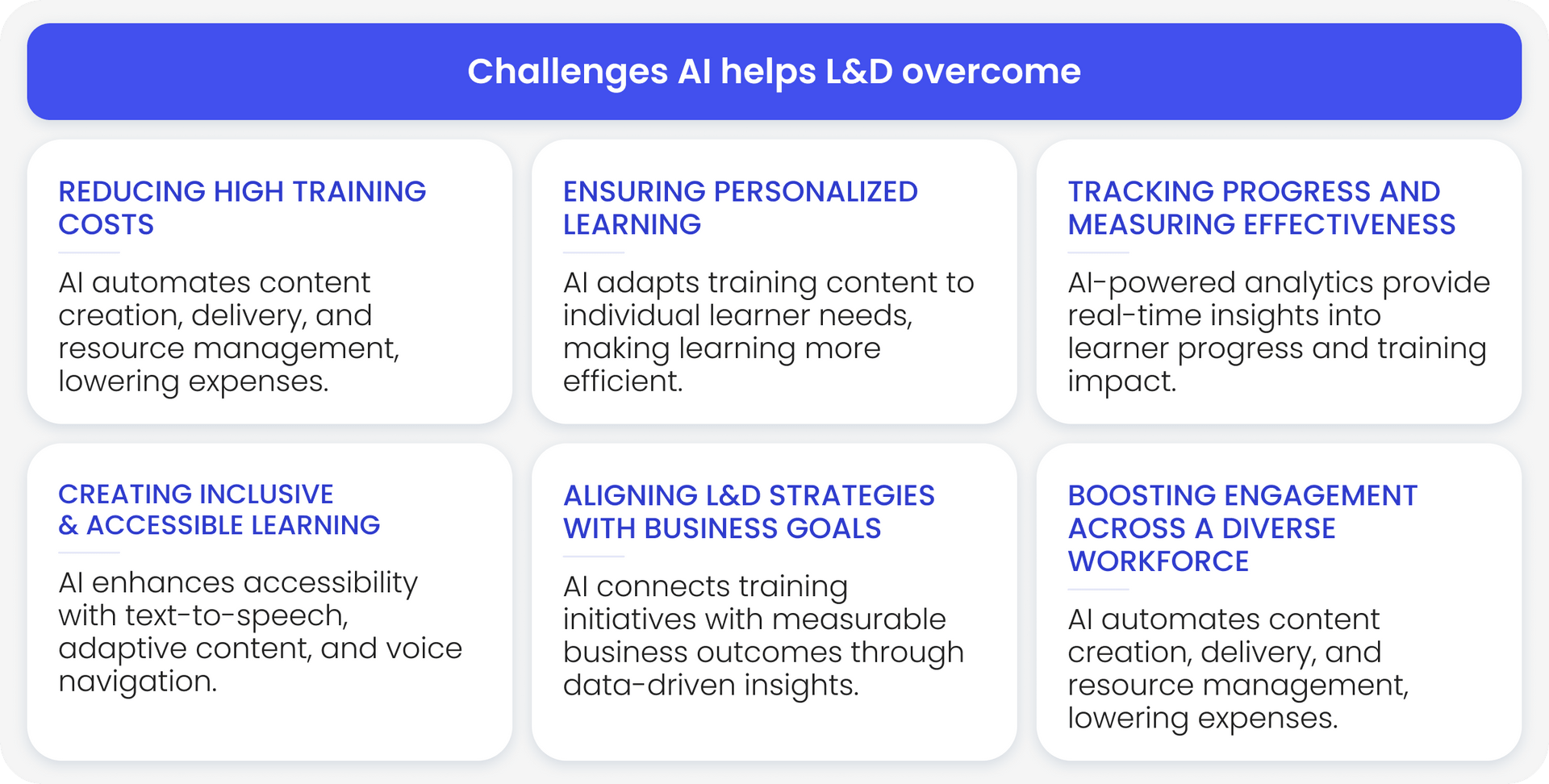
Challenges AI helps L&D overcome
What L&D tasks do AI assistants make easier in practice?
- Understanding learner preferences: AI analyzes user behavior and feedback to tailor learning experiences.
- Enhancing search: AI-powered search delivers relevant content faster by understanding intent and context.
- Creating curriculum: AI automates curriculum design by aligning learning paths with skills, roles, and goals.
- Suggesting content: AI recommends personalized learning materials based on past progress and interests.
Discover more ways AI is transforming L&D and streamlining workflows in our article.
Check out a few of our corporate learning case studies – one of them might be exactly what your L&D department needs to reach the next level!
1. AI highlights generator
An AI-powered highlights generator was integrated into an eLearning platform to summarize educational content, helping learners extract key concepts from lengthy videos, audio, and texts.
The solution streamlined content adaptation, improved accessibility, and provided detailed analytics for educators.
The result:
- 70% reduction in time spent on content creation;
- 75% lower costs for content processing and updates;
- 60% of learners’ time is saved on outlining materials.
See more details at this link.
2. Corporate custom LMS for a top German automotive company
We built a custom LMS for an automotive company, featuring course management, compliance tracking, testing, certification, and analytics.
The system integrates with corporate tools and supports 3D/AR content for an enhanced learning experience.
The result:
- 40% increase in employee productivity;
- 30% reduction in new staff onboarding time;
- Detailed visualization of each employee’s training progress.
See more details at this link.
3. AI-powered content generator for knowledge assessment
An AI-driven quiz generator was integrated into a US-based EdTech platform, automating test creation and reducing teachers’ workload.
The solution centralized data and used AI for accurate, subject-specific assessments.
The result:
- 90% quiz creation time saved;
- +4 points NPS growth;
- +27% conversion rate.
See more details at this link.
4. AI-driven question-answering system for learners
We integrated an AI-driven chatbot into an educational platform to enhance student learning.
The solution automates inquiries, delivers personalized support, and ensures seamless integration
with existing systems.
The result:
- 1-month project duration;
- >1000 requests per minute system capacity;
- +5 points NPS growth.
See more details at this link.
This is just a glimpse of the solutions we’ve already implemented. Explore more in our portfolio.
As you can see, creating a dynamic and effective learning environment is key to successfully leveraging AI in training.
So, how can you make this happen for your team? Based on the real-world implementations listed above, we’ve put together practical recommendations.
Recommendations for implementing AI in corporate training
1. Prioritize ease of use
Develop AI-driven tools specifically for L&D teams with a simple, intuitive UI that requires no technical expertise.
2. Automate content management
Leverage AI to generate, maintain, and update training materials efficiently while ensuring human oversight for quality control.
3. Enable personalized learning
Adapt training content based on employee roles, skill levels, and individual learning progress for a more tailored experience.
4. Enhance engagement
Integrate interactive elements, gamification, and scenario-based learning to keep training dynamic and engaging.
5. Ensure scalability
Implement AI solutions that can seamlessly expand to support diverse training needs, from onboarding to advanced skill development.
Shaping the quality of training processes
An economy still recovering from the post-pandemic crash is driving the need for in-company learning. Combined with effective knowledge management, this boosts productivity and innovation. However, experts highlight several barriers to transforming corporate learning.
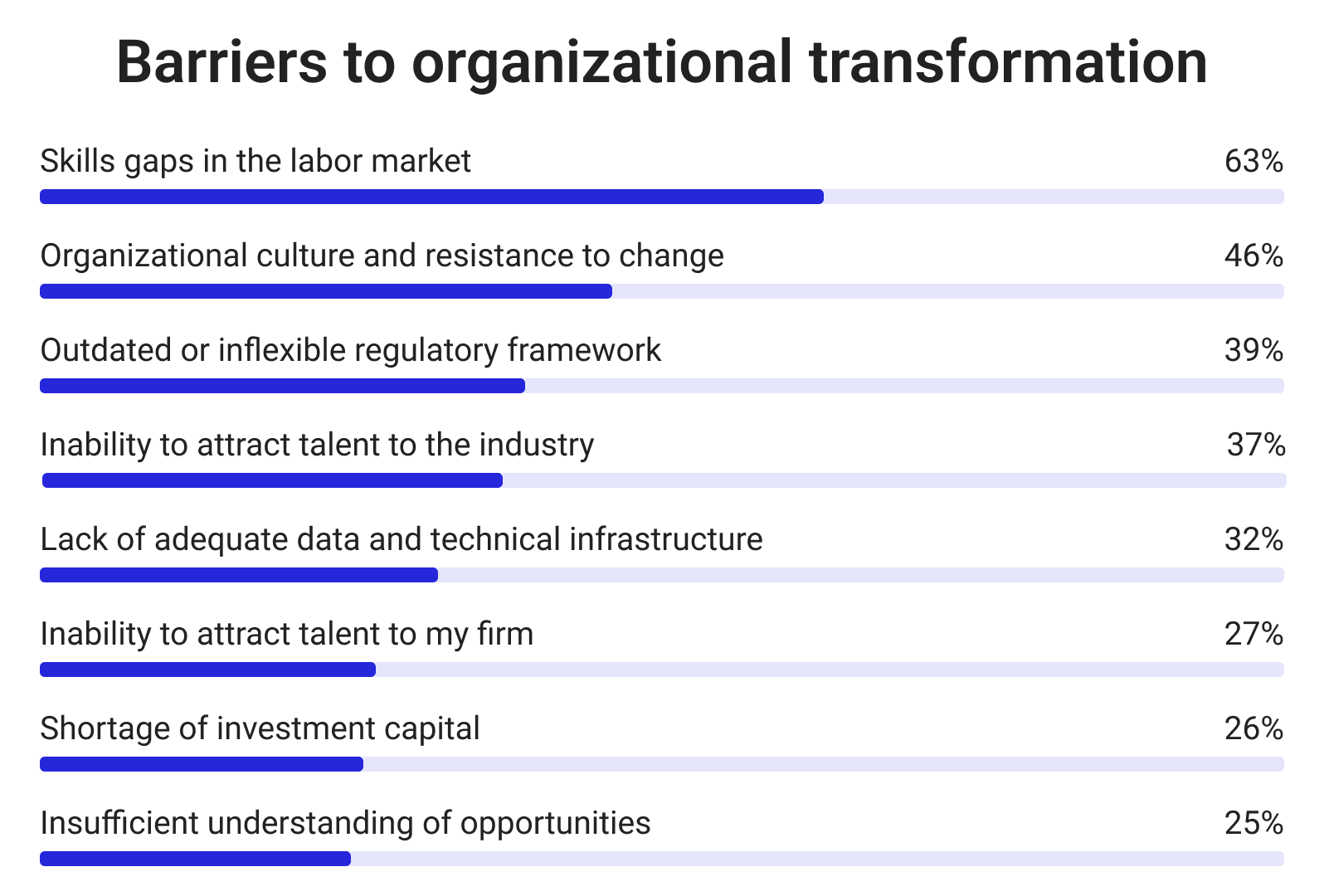
Barriers to organizational transformation
How do you overcome these barriers? Aristek experts have developed the following recommendations:
1. Align learning with business goals
Ensure training initiatives support the company’s long-term vision, addressing key skills gaps and business priorities.
Investing in employee training is an investment in the future growth of your business. In this article, we dispel a few myths associated with it.
2. Adopt a continuous learning culture
Encourage ongoing skill development through a mix of structured programs, self-directed learning, and knowledge-sharing initiatives.
3. Leverage AI & data-driven insights
Use AI to personalize learning paths, analyze training effectiveness, and adapt content based on employee performance data.
If you want to dive into the details of how AI-driven adaptive learning works, read this in-depth article.
4. Prioritize upskilling & reskilling
Focus on future-ready skills, ensuring employees stay competitive in the evolving job market.
5. Ensure accessibility & inclusivity
Design training programs that accommodate diverse learning needs, including those with disabilities, by integrating assistive technologies.
AI tool for people with reading and writing disorders
Aristek’s AI-driven solution has empowered dyslexic learners to thrive alongside their neurotypical peers, ensuring equal access to educational programs and a more inclusive learning experience.
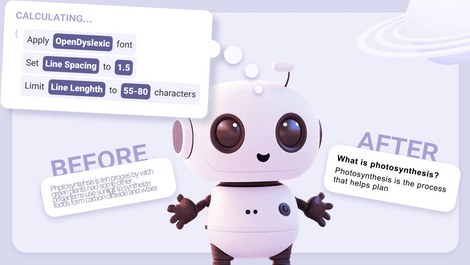
6. Measure & continuously improve learning outcomes
Use KPIs, feedback loops, and performance analytics to refine learning strategies and maximize ROI.
7. Encourage knowledge sharing & collaboration
Implement peer-to-peer learning, mentorship programs, and collaborative learning platforms to foster knowledge exchange.
To compare the different learning platform options, check out our top for 2025.
8. Optimize learning investments
Streamline resources by integrating scalable solutions and avoiding redundant or ineffective training programs.
Conclusion
Since the workforce is a strategic asset of a company, investing in talent development contributes to the business’s sustainability in the market in any field.
Corporate training software has become essential for companies, training providers, and educational institutions looking to modernize and optimize their programs. Whether training recruits or upskilling and retaining employees, a well-chosen platform ensures efficient, flexible, and effective knowledge transfer.
With the right software, companies can achieve a productive team, resulting in increased customer satisfaction and sales growth. Training providers gain increased reach, automated processes, and the ability to tailor courses for different audiences.
If you’re not already using training software, now is the time to explore its benefits. Reduce costs while creating long-term value for your organization and learners – reach out to us to know where to start.


